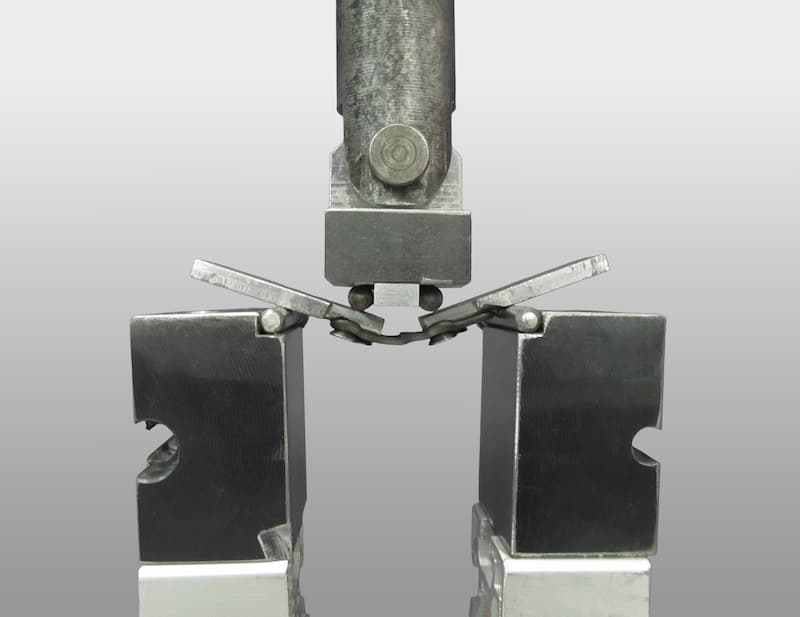BONE PLATE TESTS
At the Instituto de Biomecánica (IBV), we are an ENAC-accredited laboratory for mechanical strength and structural rigidity testing of bone plates and osteosynthesis systems.
Our tests ensure the safety and effectiveness of these medical devices prior to market launch, in accordance with international standards such as ISO 9585 and ASTM F382.. These studies are essential for manufacturers, laboratories, and regulatory bodies aiming to comply with the European Medical Device Regulation (MDR) 2017/745 and gain access to international markets.

ACCREDITED BONE PLATE TESTING ACCORDING TO ISO 9585 AND ASTM F382
At IBV, we conduct tests on bone plates and osteosynthesis systems to determine their ability to withstand mechanical loads under real-use conditions.
Among the main tests we carry out, the following stand out:
- Four-point bending test: Evaluates structural stiffness and flexural strength in plates for medical devices for orthopedic, traumatology and maxillofacial surgery.
- Determination of mechanical strength: Static and dynamic load tests to validate the durability of bone plates.
- Regulatory compliance: We apply recognized international standards such as ISO 9585 and ASTM F382, essential for the certification of these surgical devices.
In addition to the delivery of the results report, at IBV we provide added value with technical observations and optimization strategies to improve the safety and performance of the bone plates before their release to the market.
Request information from our technical team

LABORATORY SPECIALIZED IN BONE PLATE TESTING
The IBV biomechanics laboratory has advanced technology and specialized equipment for the evaluation of medical devices such as osteosynthesis plates for maxillofacial and orthopedic surgery and traumatology.

Osteosynthesis Plate Testing
● Evaluation of mechanical interaction and structural stabilityin osteosynthesis systems...

Test equipment and technology
● Advanced configurations for four-point bending tests, ensuring accuracy in the measurement of structural stiffness.
● High-precision instrumentation to evaluate the behavior of the devices in real conditions of use.
ISO 9585 Standard
● Application of osteosynthesis plates in bone fracture surgeries requiring stable and durable fixation.
ASTM F382 Standard
STANDARDIZED TESTING IN TRAUMATOLOGY AND ORTHOPAEDIC SURGERY
IBV assays are designed to validate bone plates used in demanding surgical procedures:
These regulations ensure that the bone plates tested at IBV that have passed the validation process comply with the safety and efficacy requirements demanded by international regulatory bodies.
ADVANTAGES OF TESTING BONE PLATES IN AN ACCREDITED LABORATORY
At IBV, we not only evaluate the compliance of bone plates, but also provide a strategic approach through detailed analyses and technical recommendations to optimize product performance.
- The only laboratory accredited by ENAC for bone plate testing 519/LE1105.
- Compliance with international standards such as ISO 9585 and ASTM F382.
- Traceability of measurements to national and international standards, ensuring the reliability of test results for third parties and public authorities.
- A quality management system based on ISO 17025, under which all testing activities are conducted.
- Essential evaluation for compliance with the European Medical Device Regulation (MDR) 2017/745, facilitating CE certification.
- Critical validation for manufacturers seeking to introduce surgical plates into international markets.
- Simulation of clinical scenarios, ensuring that the bone plates meet the biomechanical requirements of their surgical application.
Contact our technical team
We will help you define the necessary tests to validate the safety and efficacy of your bone plates on the market.
Frequently Asked Questions
Why is it necessary to perform strength and structural stiffness tests on bone plates before their commercialization?
These tests reproduce the real biomechanical conditions to which the implant will be subjected in the body, verifying its ability to withstand bending, compression, and fatigue loads.
In addition, they are mandatory to demonstrate compliance with the European Regulation (EU) 2017/745 (MDR), a prerequisite for obtaining CE marking.
What do the ISO 9585 and ASTM F382 standards evaluate in osteosynthesis plate testing?
ISO 9585: defines the methods for measuring the structural stiffness and bending strength of metallic osteosynthesis devices.
ASTM F382: establishes the procedures for evaluating the strength and durability of plates used in trauma, orthopedic, and reconstructive surgery.
The Institute of Biomechanics (IBV) applies these standards in its accredited tests, ensuring that the plates comply with the requirements established by European and international regulatory bodies.
How is the four-point bending test on bone plates performed?
It consists of applying a controlled load at two intermediate points while the plate is supported at its ends, simulating the real stresses experienced when fixing a fractured bone.
This test helps identify deformations, failures, or losses of stability in the plate, providing key information for the design and validation of the device in accordance with ISO 9585 and ASTM F382.
What advantages does an ENAC-accredited laboratory, such as IBV, offer for bone plate testing?
The IBV is the only laboratory in Spain accredited for bone plate testing (519/LE1105) under the ISO/IEC 17025 standard, ensuring:
- Traceability of measurements to national and international standards.
- Regulatory compliance with ISO 9585, ASTM F382, and Regulation (EU) 2017/745 (MDR).
- Simulation of real clinical conditions, validating plate strength under demanding surgical scenarios.
How do IBV’s biomechanical tests help optimize the design and performance of osteosynthesis plates?
Based on experimental results, its biomechanics specialists offer insights into structural behavior, stiffness, and stability, helping improve load distribution and implant durability.
This approach turns testing into a tool for innovation and continuous improvement, beyond a mere regulatory requirement, facilitating the introduction of safer and more efficient products into the international market.

